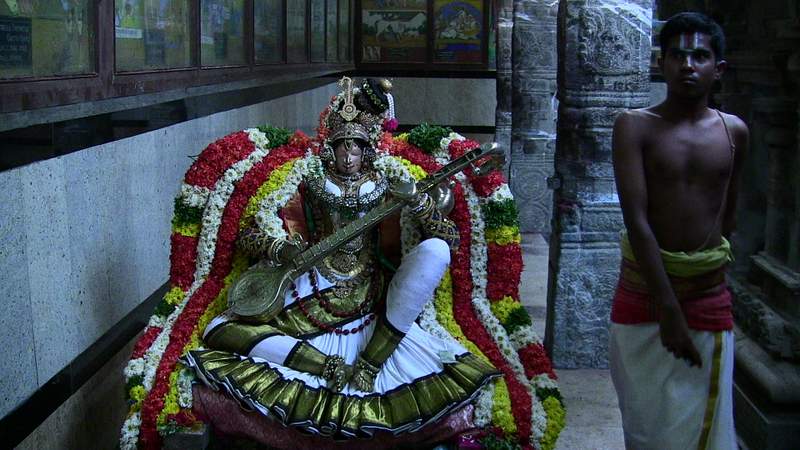Kenopanishad Introduction:
The Kenopanishad Upanishad is called so because it begins
with the word “Kena”. This Upanishad is one of the dasopanishad.
The translation of the following manthram from Rig Veda
provides the summary of the Kenopanishad. The meaning of the following manthram
will help us to understand this Upanishad properly.
Gaayanthi
twa gayathrinau rchadyarkamarkina: I
Brahmaanastwa
shathakrata udwamshamiva yaemirae II
The verbatim meaning of the first verse in the above manthram is, “Oh Indra!
Those who know Sama vedam sing your praise; those who know Rig vedam worship
you; those who know Yajur vedam and have performed 100 yagams praise you and
all these people make you magnificent with their praise.”
There are two commentaries for the Vedas. These commentaries
are rendered by Bhatta Bhaskarar and Sayanachar. The above hymn is directed
towards Indran. Both scholars agree that “Indran” referred by the hymn is Lord
Narayanan. Indra refers to a person who is wealthy and there is none who is
wealthier than Sriyapathi Lord Sriman Narayanan. Thus, the above verse refers
to the Supreme Brahmam, Lord Sriman Narayanan as Indran.
Bhatta Bhaskarar said that, the word ‘wamsham’ in general
refers to lineage and also to bamboo shoot. He said that in the above verse,
wamsham refers to bamboo shoot. The word “wamsham” is used in the above hymn to
indicate that, the Lord’s glory grows like a bamboo shoot when we eulogize Him.
Sayanachar explained the above manthram by stating that, the Lord’s glory is
uplifted like the growth of a good lineage. The explanations provided by both
scholars are not very convincing as, how can any one of us be capable of
increasing the glory of the Supreme Lord? The actual meaning of the word
‘wamsham’ is given by Swami Vedanta Desikan in ‘Varadaraja Panchasat’.
Swami Desikan says that, he doesn’t know how to praise
the Supreme Lord. Swami compares his knowledge to that of the insignificant
light emitted by a glow worm. Hence, he asks the Lord to bless him with the
knowledge as well as words needed to sing the praise of the Lord. Swami states
that, the Lord created every one of us to serve Him. Thus, if He doesn’t give
us the ability needed to serve Him, the purpose of creating us is not met.
Swami says that the Lord produced music by playing the flute. The flute by
itself does not have the capacity to produce music like that, we don’t have the
capacity to serve the Lord; the Lord has to play us like the flute to give us
the capabilities required to serve Him.
With the help of the above explanation by Swami Vedanta
Desikan, we can translate the above vedic verse as, “those who know Sama vedam
sing your praise; those who know Rig vedam worship you; those who know Yajur
vedam and have performed 100 yagams praise you and they do so because, you made
them praise you by playing them like the flute.”
Swami Vedanta Desikan requests the Lord Ranganatha to
play him like the conch. He asks Lord Srinivasa to play him like the veena and
he prays to Lord Varadaraja to play him like the flute.
Let us keep in mind the explanation provided by Swami
Vedanta Desikan while studying Kenopanishad.
 |
| Mannargudi Rajagopala Perumal Mohini Alankaram |
Kenopanishad Question 1:
Kenopanishad is in the form of question and answer. The
answer to the first question asked by the disciple to his guru is provided in
the above paragraphs. The disciple asked four questions in the first manthram
as shown below.
By whom is the mind urged to flow towards the object of
its desire? At whose bidding does the chief prana proceed to do its function?
Who incites people to utter words? By whom is the eye and ear directed to see
and hear?
The acharyan answered the disciple’s query. He said that,
“the ear, mind, prana, speech and eye are directed by the one who is ear of ear, mind of mind, speech of speech, prana of
prana, and eye of eye. By knowing Him as the Supreme Being and being devoted to
Him we can attain emancipation by traveling via the archiradhi marga.
There is someone who controls the sense organs by giving
them power but, He cannot be perceived by the senses. He cannot be known by
ears, eyes, speech or mind. He controls all but He cannot be controlled; if you
understand this, and then stay devoted to Him, you will achieve emancipation.”
This Upanishad explains what is meant by “can’t be known”.
We will continue with the acharyan’s reply in the next
post.
Reference:
This series is
based on the notes I took after listening to the discourse in Tamil
on Kenopanishad by Sri U.Ve.Karunakarachariar Swamin. This series is for the
benefit of people who do not understand Tamil. Those of you who understand
Tamil please refer to the following link to listen to the original discourse. https://www.youtube.com/watch?v=1wBXKT9cCQo
I
have done my best to take notes with due diligence; any error(s)
in the series is because of my mistake only. I
apologize in advance for any errors that I have made while writing this series
.






No comments:
Post a Comment
Note: only a member of this blog may post a comment.